My Musical Career | Part Twenty
The Evansville Years – Part Two
“The Fourth Piece of the Puzzle”
In my previous blog post, I described my new position (or positions) in Evansville and Owensboro, with only a little blurb about the fourth part of the puzzle. This was what was called an “Artist-In-Residence” position, and was not originally (or later) a part of the consortium. This residency involved going into selected schools and bringing music into the curriculum – science, math, art, etc. This was to last a semester, and was to conclude with an evening’s program at the selected school. Funded by a grant from the Indiana Arts Council (which was initiated and written by Mrs. Suzanne Beeson, an influential individual with connections to Evansville’s powerful Petroleum Club), for my efforts I was to be paid a stipend of $5,000.
The spring semester was selected as the time for me to actually put the program in place, using the fall semester to get my bearings in Evansville and settle in at the U of E and the orchestras, as well as get my ideas for the program in order and have them ready to go at the beginning of the spring semester.
To be honest, upon arrival in Evansville I had no earthly idea of how I was going to approach the project, and I initially dreaded the idea, but as the fall semester proceeded, and with the help of of a couple of strategy sessions with Herb and Carol (who were very supportive and experienced), I was able to put together a strategy for the spring semester. More about this later.
Settling In
I mentioned earlier that I was able to secure a basement apartment at the home of Mrs. Ann Cassidy at 2165 Bellemeade Avenue, just a short four block walk from the university. It was a blessing to be so close to the school, and to the shopping center and to public transport. A lot of my logistical problems were solved in short order, as I still did not have a driver’s license.
However, there were still rehearsals and concerts in downtown Evansville and Owensboro. For going downtown, I relied at first on the city’s public bus system, which ran fairly regularly. However, there were times when the orchestra rehearsed and performed outside the time frame in which the buses run, in which case I rode in with various orchestra members. For Owensboro events, I was totally dependent on my fellow consortium members and they were very good in making sure that I had a ride to and from Owensboro.
U of E/Evansville Philharmonic
Since the Evansville Philharmonic and U of E positions made up the lion’s share of my job, I’ll describe my experiences with both in this section. I’ll start with my position as adjunct instructor of percussion at the
university. My duties included teaching the applied percussion students, majors as well as minors; teach percussion methods, and teach and conduct the UE percussion ensemble.As I mentioned in the previous blog, my studio/office was located in the lower floor of the then Fine Arts building, and it was equipped with a Deagan xylorimba and music stand; a desk with telephone, and a filing cabinet about half full of method books and ensemble and solo percussion music. This was the first time I had my own office, and at the time I thought it was cool. The studio next door was empty of office furniture, and as it had either an old marimba or a set of Rogers Acu-Sonic timpani in it, was used as a practice studio. Most of the marimba occupied the studio.
I had three percussion majors at the time: William Adrian Jones, who went by the nickname A.J.; Rebecca Sigafus, who was known as Becca; and James Geisler, who was a trumpet major with a passion for timpani and percussion, and who transferred his major from trumpet to percussion. He went by the nickname of Jay.
A. J was a very diligent student, and his ultimate major was music business. His interest lay in eventually writing half-time shows for the marching bands, and he naturally gravitated towards the rudimental snare drum and marching percussion. Becca had a great empathy with people and her ultimate major was music therapy. Jay was a born performer, so he naturally was enrolled as a performance major. I had two percussion minors – students who loved music as an avocation and majored in other disciplines. Eric Bramlet and Dan Dierlam took half-hour percussion lessons from me (my percussion majors had a full hour lesson each) and were also enrolled in band and percussion ensemble.
These five students constituted the core of the percussion ensemble as well as the percussion sections of the university band and orchestra.
Most of my colleagues at U of E were also members of the Evansville Philharmonic and Owensboro Symphony Orchestra. Dr. David Wright was the conductor of the University Orchestra and clarinet instructor as well as principal clarinet and personnel and manager of the EPO. He was an excellent musician and he welcomed me warmly and encouraged me during the whole of my tenure. He also encouraged me to coach the student percussion section of both orchestra and later the symphonic band.
Ed Lacy was the principal bassoonist of the EPO and on the woodwind faculty at U of E. Tall, sandy-haired and with a bit of a southern drawl, Ed had a down-home quality which put one at ease, and was a top-notch musician and teacher. He was also a member of the Owensboro Symphony, and another of my colleagues who welcomed and encouraged me.
Sherry Sylar, the oboe teacher and principal oboist of both EPO and OSO was there for only my first season as she successfully auditioned for and was hired as the associate principal oboe with the New York Philharmonic, a position she still holds with distinction. I remember her as being a hard-working musician, always working to improve her formidable skills, and yet always treating her colleagues with consideration. A delightful colleague, and I was sorry to see her move on. Peter Moore was the solo horn and horn instructor at the time, and Bill Bootz was trombone instructor and principal trombone of both orchestras. I had many a conversation with Bill and found him to be an excellent musician and colleague. Principal trumpet Jim Burson was one of the stars of the EPO and OSO as well as one of the music department’s heavy hitters. A great player and a teacher of note, he inspired many, many students. Carol Dallinger, the principal second violinist of the EPO, headed the Suzuki violin program at the U of E, and was another of the fine colleagues who welcomed me to Evansville.
Greg Davis was then the head of the piano department and a fine soloist in his own right. An extremely talented individual, he doubled as a more than competent french horn player, and served as the EPO’s fourth horn as well. Anne Hastings (as she was then) was a newly hired piano instructor at U of E, and also served as the piano/celeste player for the EPO. If memory serves me well, I believe she was also a double threat – as a violinist. She played violin in the orchestra when there was no keyboard part involved. She was also a good friend and colleague, filling me in on the ins and outs of academic life.
Stewart Kershaw was the music director of the Evansville Philharmonic during the whole of my tenure, and I found him to be a very interesting individual. About forty years old and spare of frame, about medium height, he was from the United Kingdom and spoke in a very decided British accent. His conducting technique was impeccable – clear – easy to follow. He was fairly efficient in rehearsal and turned out well balanced programs – full of challenge to both players and audience alike. He was a very stylish conductor – neat and impeccable in tails. He reminded me a little of Sir Malcolm Sargent, the legendary British conductor who was the conductor of the Last Night of the BBC Proms for many years. He was also very supportive of my efforts in the EPO, and I performed more than adequately enough to remain in his good graces for the entire period of my tenure in Evansville.
My first program included Dvorak’s “Carnival” Overture and the Brahm’s Second Symphony.
“Interesting” Instruments
As I mentioned earlier, our first rehearsals for a series were at the UE ensemble room, which was then equipped a set of Slingerland Rhapsody timpani. These instruments had seen better days, and while in better condition the Albany Symphony’s old timpani – it was a bit frustrating to play on such poor instruments.
Fortunately, I only had to put up with those drums for the two rehearsals on the Sunday before the concert weekend – the first rehearsal started at 2:00 pm and ran until 5:00 pm; and the second rehearsal went from 7:00 pm until 10 that evening. Then, the venue changed to the Evansville Civic Center downtown for the Friday evening rehearsal at 7:00 pm, and for the Saturday dress rehearsal at 10 am and concert that evening at 8 pm. The instruments I played on for the Friday and Saturday rehearsals and concerts were a set of Ludwig Dresden pedal timpani, ca. 1975 vintage.
My first concert was a success and I was warmly congratulated by all – from Stewart on down. As a matter of fact, I was a bit of a celebrity as Mrs. Beeson (she of the Artist-In-Residence grant) and the orchestra arranged for pictures and an article to be placed in the Evansville Courier, announcing my arrival in Evansville and showing me in action (albeit on the old Slingerlands at the U of E). I was not used to being in the spotlight, and came to understand that this was good publicity for the residency, and good residual publicity for the orchestra, U of E, and of course, yours truly.
U of E gets a new set of timpani
From my first weeks in Evansville, I was determined to demote those Slingerlands and replace them with a set of Professional Symphonics. I couldn’t go to the administration and demand new instruments – that would have been like shooting myself in the foot. I bided my time, using them when I had to, and having quiet discussions with my colleagues and kind of let nature take its course – through the grapevine. They could hear and see just how inadequate those timpani were for a university music program that had aspirations towards excellence.
The matter was eventually settled in the spring of 1981, near the end of my first season, when the school administration decided that it was time to demote the old Slingerlands and replace them with a new set of Ludwig Professional Symphonic timpani. It was decided that the purchase be handled by the local music dealer, but that before the drums were to be shipped to the university from the Ludwig plant, which was still at North Damen Avenue
The most memorable part of my expedition was the trip back to Evansville. I flew up on US Air, and the flight there was unexceptional. However, the flight back was a nightmare. The plane we were on could not take off due to mechanical difficulties, so those of us who needed to be in Evansville that evening were given the option to fly in on a Beechcraft Bonanza. I had never before flown on a small plane, and was miserable the whole time. While it was certainly scenically interesting, the motion of the small plane made me nauseous. Mind you, I did not get sick, but was in that state of being “not sick, but about to be.” Mercifully, the flight lasted only about an hour and a half, and I was down on terra firma about 5:30 pm.
The drums arrived about a week later, and proved to be a hit. The old Slingerlands moved into the studio next to my office, and served as practice timpani, replacing the Rogers AcuSonics, which were hated even more cordially then were the Slingerlands.
I’ll go into more detail with regard to the AcuSonics later, but suffice to say these new Ludwigs improved the musical situation at U of E significantly.

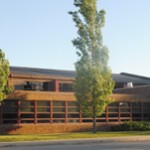
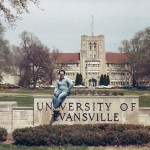
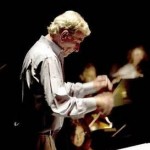
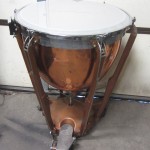
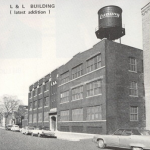
Recent Comments